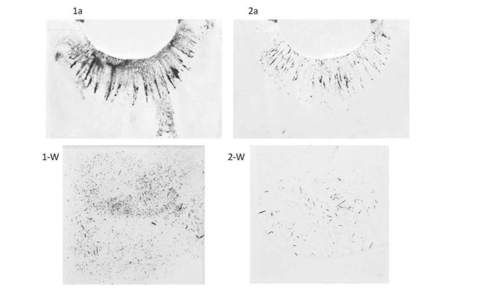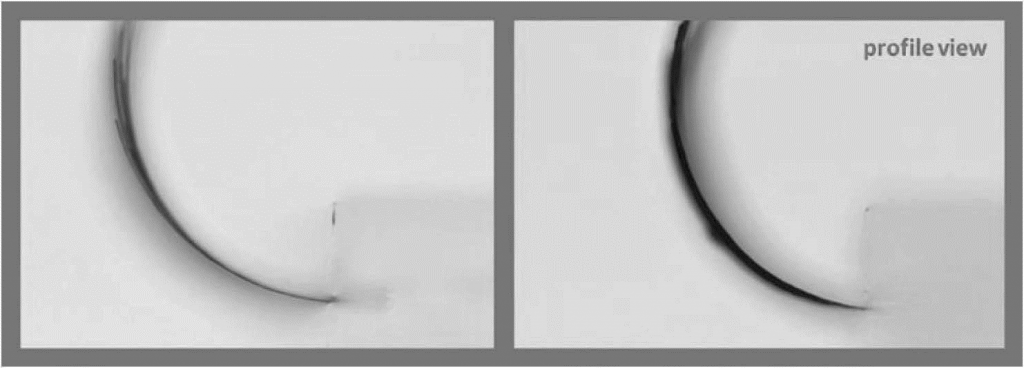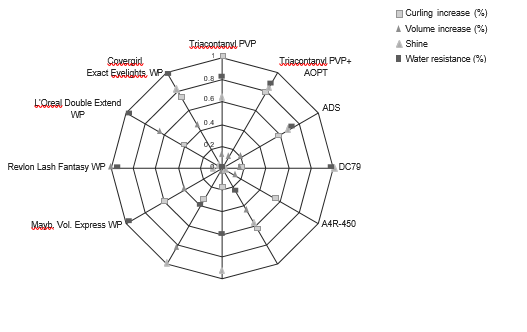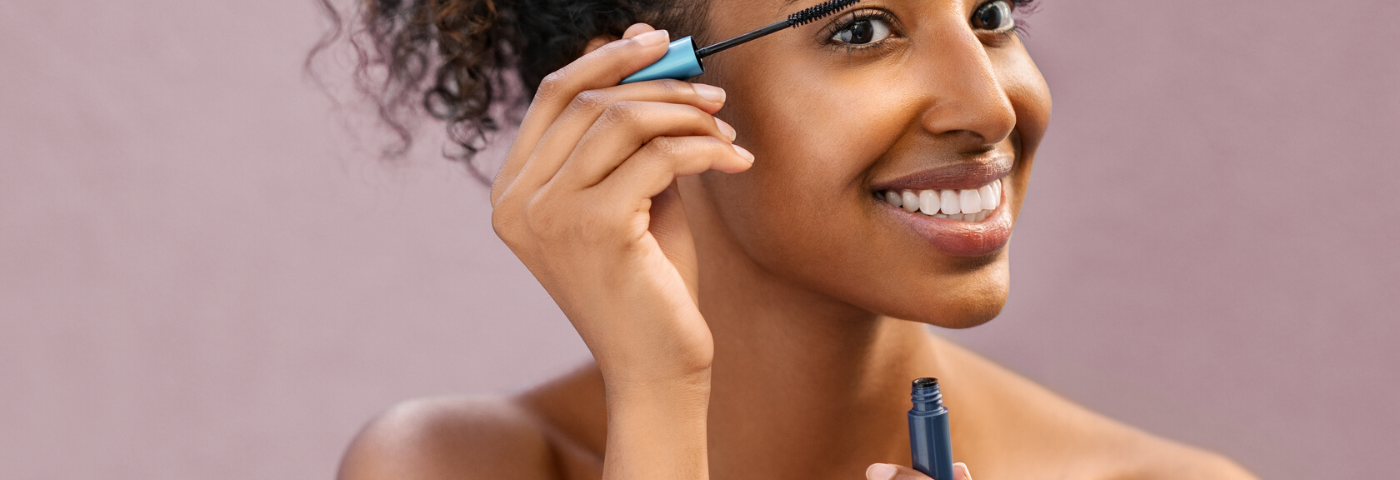Abstracted Section 6.5.1 Harry’s Cosmeticology, 9th Ed.
6.8.1 Mascaras
The formulation of mascaras has been a very active field over the last 20 years as formulations are requested to improve very different aspects of eye lashes: color, physical characteristics such as curling and thickening, and daily wear resistance such as water and sweat resistance [7]. These effects can be almost instantly experienced and judged by the consumer, since mascara has a direct impact on visual perception. One must also keep in mind when formulating, that mascara formulations need to be adjusted to the applicator used in a final product, especially in terms of viscosity and application fluidity versus solvent evaporation.
Mascara formulations are found of two main types: water based and organic- solvent based. Both types can give smooth and homogenous applications on eye- lashes. Also, a very important aspect of mascaras is that formulations need to be matched with applicator brushes. This point is illustrated by the numerous patents existing on mascara applicator brushes [8–11].
a. Basic Formulation
A general composition breakdown of mascaras is given in Table 26.1 as a base of discussion to follow.
Table 26.1 Typical mascara ingredients and ranges of commonly used concentrations
| Ingredient | Concentration (% wt.) | Examples |
| Color | 1-12% | iron oxide, mica pigments |
| Emulsifier | 3-10% | myristoyl, penta/hexapeptides |
| Emollients | 25-50% | oils (jojoba, wheat, argan) |
| Texture modifiers | 5-20% | hydroxycelluose, waxes |
| Preservative | 0-1.5% | phenoxyethanol, propylparaben |
| Film formers | 1-8% | silicones, dimethicone |
| Solvent | Q.S | water, petroleum distillates |
The primary purpose of a mascara is to give visual impression of long dark eyelashes to enhance the beauty of the eye area. Therefore, a first component will be the color pigments. For a best contrast of the visibility of eyelashes against the background skin and eye, black is the most common primary pig- ment and is given by black iron oxide particles. Titanium dioxide is often added to disperse black pigments and give a deeper black perception The main color can be modified as a mass-tone color by addition of light-absorption pigments such as browns, reds, and blue pigments (e.g., mica-based pigments). Two types of light-effect pigments can be used: light-absorbing (dye pigments) and light- reflecting/interfering (multicoated interference pigments). The second type is generally used in mascaras for its better perception due to selective color of light being reflected but also due to the lower toxicity of mica and its outer coating when in contact with eyelid skin and the humid mucosal membrane hosting lash roots.
Stronger mascara colors are also present on the market and represent a smaller fraction of consumer uses.
Emulsifiers are then added to create a stable dispersion of these pigments.
Thickeners such as hydroxyethylcellulose serve to thicken this suspension and can add volume to the mascara coating applied to the eyelash. They have a wide compatibility with most formulation bases, and while being commonly used, they also increase viscosity so that the system needs to be a little more fluidized (e.g., oils or emollients) for a smooth flow of mascara application.
Oils are commonly present to bring both better adhesion on the keratin of the lash keratin surface but also to fluidize the formulation to regularize flow and homogeneity during application. Oils also bring nourishment to the lash fiber by slightly penetrating into its cortex. Thickeners, such as waxes, have an opposite effect on the formulation by increasing viscosity but also induce a slight solidification of the mascara film during drying on eyelashes as the solvent evaporates. For this reason, it is generally recommended to move the applicator brush up and down in mascara tubes prior to use. The effect is to coat the locality, refluidize the formulation, and have a fresh layer of formula- tion on the brush when used. The same is recommended when using mascara consecutively.
b. Advanced ingredients
Specialty ingredients can be included to give a better texture or regularity when applied with a brush as well as additional benefits: adhesion promoters, formu- lation stabilizers, thickeners, polymers, color pigments, active ingredients, and fragrance. These ingredients are more and more frequently added to enhance the mascara film formation and stability on the eyelash and to bring new benefits to the final formula, such as water and wear resistance.
A detailed water-based mascara formulation is shown in Formula 26.6 below. This formulation has been shown to bring lash curling and water resistance but also a modest increase in lash thickness (volumizing effect).
Formula 26.6. Volume curling mascara with high water resistance
| Phase | Ingredients | % (wt) |
| A | D.I WATER Disodium EDTA (Versene Na2 Crystal) Triethanolamine (TEA 99%) Acrylic acid/VP Crosspolymer (Ultrathix p-100) Xantham gum (Keltrol T) | 45.42 0.1 0.38 0.5 0.3 |
| B | Water Polyninyl pyrrolidone (PVP-K30) | 10 1 |
| C | Water Polyninyl pyrrolidone (PVP-K30) | 10 1 |
| D | Glyceyl stearate and Laureth-23 (CERASYNT 945) C18-36 acid triglyceride (Synchrowax HGLC) White beeswax Stearic acid Copernicia cerifera (Carnauba) wax SP63 Euphorbia cerifera (Candelilla) wax PEG-20 stearate (Lipo PEG10-S) Tricontanyl PVP (Ganex WP-660) | 3 5 5 2 3 1 2 0.5 |
| E | Triethanolamine (TEA 99%) | 1 |
| F | Water Allantoin Vitamin E (Tocopheryl acetate) Acrylate/alkylmethacrylate copolymer (Allianz OPT) | 5 0.1 0.2 1 |
| G | Phenoxyethanol, octanediol (optiphen) | 1.5 |
| Total: | 100 |
Procedure
- Pre-weigh water and disodium EDTA and mix until clear; add TEA and mix until clear. Sprinkle Ultrathix slowly until all in.
- Transfer to homomixer and slowly add xantham gum.
- Premix ingredients of phase B and add to phase A; begin heating to 75–80°C
- Weigh ingredients of phase C and pulverize using blender for about five min- utes. Then, add to previous mixture and continue homogenizing.
- Separately, add ingredients of phase D and heat to 75–80°C while mixing.
- Add phase D to phases ABC while homogenizing for about ten minutes.
- Add TEA (phase E) and continue homogenizing for ten minutes. Begin cool- ing the mixture to 55°C.
- Switch to sweep agitation. Add phases F and G and cool to 25–30°C.
Adhesion promoters such as silicones improve film compatibility of the mas- cara with the keratin of the eyelash cuticles. Adhesives help to prevent mascara flak- ing under daily stresses such as finger contact or bending or inter-eyelash friction. Stabilizers are used as homogenizers in the mascara. Thickeners such as hydroxyl celluloses provide richer coating applications on the lash and can thus bring volu- mizing properties to the finished product. Mechanical benefits such as anti-flaking or water resistance can be given to a formulation via polymers such as Allianz OPT or Ganex line. They provide two benefits to the mascara film applied on the eyelash: trapping of dyes and global film integrity. They give hold to the mascara dye particles by forming a three-dimensional network around them and throughout the film and thus prevent their release when lashes come in contact with waterous media such as tears. In addition, polymers give film integrity to the mascara while still adapting to the bending stress of eyelashes during daily activities. This prevents mascara breakage with risk of dye leakage or potential flaking of the film.

Figure 26.5. Effect of 1% acrylate/C12–C22 alkyl methacrylate copolymer on wa- ter resistance: Test 1 (Top): Bending under wet conditions and Test 2 (Bottom):
particles released after 60 seconds of eyelash immersion in deionized water. (1) Mascara base without polymer; (2) mascara with 1% acrylate/C12–C22 alkyl meth- acrylate copolymer. In all cases, mascara was applied on eyelashes and given 20 minutes drytime at air prior to tests.
Much work is devoted by finished product manufacturers to prescreen and test polymers and polymer mixtures for they glassy transition temperature, i.e., the temperature at which the material transitions from liquid to an amorphous glass-like state. A polymer mixture with a transition temperature near 68°F (20°C) would provide stability and luster to the applied mascara. The same polymers can also bring curling to a mascara (Figure 26.6)

Figure 26.6. Side view of eyelashes before and after two-stroke application of formulation 1. Artificial eyelashes made of natural untreated Caucasian hair have been used here, mounted in a linear holder to control base hair alignment. The increase in curvature can be clearly seen on the right picture.
A multidimensional approach to polymer benefits in mascaras can serve the formulator to choose appropriate ingredients faster. A large number of commercial polymers have been evaluated in the mascara base at 1% active concentration (For- mula 26.5). Four properties of mascaras have been evaluated as described above: volume, curling, water resistance, and shine. Results are graphed together on a spider chart to show best combinations of polymers providing multiple benefits to consumers. For each property, scales were normalized with the top performer in each category. For comparison, the six top-selling commercial mascaras were also tested. While most commercial products show very good performance in one property, only two of them showed two benefits at a high level. In comparison, 1% triacontanyl PVP showed high water resistance as well as curling and some degree of shine. In a 0.5% combination of triacontanyl PVP with 0.5% AOPT, all three properties were brought up to 80% of the highest performances.

Figure 26.7. Global overview of mascara performances in each of four properties: volume, curling, water resistance, and shine (calculated from ten line profiles obtained by macrophotography followed by shine calculated by means of the Reich- Robbins formula)
Color pigments, such as micas, can bring highlights and color shades to the applied mascara. Finally, active ingredients can be incorporated inside mascaras or mascara pretreatments for various purposes such as reinforcing thin lashes or stimulating lash growth. Growth-stimulating actives are intended to penetrate into the lash follicle and act on the cell keratinization and differentiation.
Don’t miss the difference between sunscreens & self-tanning lotions.


are mascaras difficult to preserve? particularly for mold and fungi?
what preservative booster do you recommend for this micro organism when using Phenoxyethanol as the primary one?
Hi have you a mascara recipe using natural ingredients.?